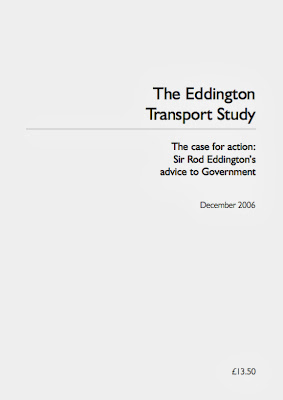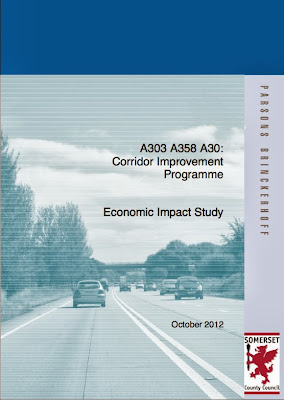One of the difficulties in pressing forward the argument for a bypass for Winterbourne Stoke and Stonehenge is that we need good information to inform our position and to rebut the arguments of the opposition. Often, the information we need is deeply buried and seemingly inaccessible and is often under the control of the very people and organisations who are proving a stumbling block.
Part of the mission of this blog is to wheedle out that information, provide easy links to it so that you can read it for yourselves, but also to consider whether the data that is being used is valid. Just because information comes from an official source doesn't mean it is credible, doesn't mean it makes the case that is claimed and sometimes it has been (let's be charitable here) mis-interpreted by the opposition. It is for you to make up your own minds whether that misinterpretation is accidental or wilful.
Links to this information will appear both in the text of related blog posts, but also under the "Favourite A303 Links" section to the right of the blog posts. Although the blog has an easy search facility, we wanted all the useful stuff in one place to save time.
Of course, not all of the information from official sources is readily available. However, we can make use of the Freedom of Information Act (FOIA) to try and get at much of that. It is very easy to do and essentially means you just write to the official body you think controls the information and ask them for it. In simple terms, if the information you have asked for is not exempt from the FOIA (eg it's a national security issue), it isn't going to cost too much and take too long to answer it (disproportionate cost to the public interest value) and isn't covered by any other statutory "get out" clauses, then the information owner is legally obliged to provide the answer within a very short space of time. If they don't, the whole issue can be escalated to the Information Commissioner for review. The good news is that much of the information these days is held in searchable, electronic databases (and more historical data is digitised daily), so rejecting an FOIA on the grounds of cost is becoming increasingly indefensible. The best FOIA questions are those where you may already know, or strongly suspect, what the answer is, but want original documents or hard facts and figures to reference in making your case.
The whole FOIA process is made so much easier if you use the What Do They Know? website. This is a smashing resource that gives you advice on how best to formulate an FOIA request, sends it off to the appropriate authority on your behalf, tracks progress and warns you if the recipient is failing to respond in time. It provides an easy way of commenting on a response and then asking supplementary questions. However, the biggest advantage is that the whole process is public. If you make an FOIA request on your own, only you get the answer, it isn't public, isn't searchable and so isn't as useful to others.
In a campaign like this one, getting the information into the public domain is vital; so if you are tempted to make an FOIA request, please use What Do They Know.
So, what information is there already. Well, there are already links to the Trunk Road Act (1936) and the later amendment to it, the Trunk Road Act (1946). All good historical scene setting on trunk roads. If you like the minutiae of Acts of Parliament, they may be of interest to you.
There are two excellent recent documents that everyone involved in this campaign should read and refer to. The first is "The Eddington Transport Study" of December 2006 - written for the British Government by the Australian former CEO of BA, Sir Rod Eddington
The Eddington Transport Study set out the case for action to improve
road and rail networks, as a "crucial enabler of sustained productivity
and competitiveness". The report's main conclusions were that Britain
has transport networks that provide the right connections, in the right
places, to support the journeys that matter to economic performance. But
roads in particular were in serious danger of becoming so congested,
the economy would suffer. Something most of us would agree with.
The second document, and by far and away the single most important information source we have come across, so far, is the "A303, A358, A30: Corridor Improvement Programme - Economic Impact Study" of October 2012. This most boring sounding report was produced by Parsons Brinckerhoff for Somerset County Council. What on earth has a report commissioned for Somerset County Council got to do with the little village of Winterbourne Stoke in Wiltshire, rat-running on the roads around and the problems at Stonehenge?
Well you might ask. Somerset Council are to be congratulated for an inspired piece of work. Parsons Brinckerhoff undertook an appraisal of the economic benefits of dualling the full length of the A303 between Amesbury and Honiton as well as the A358 between Ilminster and Taunton. The bottom line, for all of us, is that if the A303 and the A3588 were both dualled, then in the context of this plan as a whole, for every pound spent on providing an A303 by-pass for our village of Winterbourne Stoke, the economy would recover £1.80. For every pound spent putting the A303 in a tunnel the economy would recover £1.80. The economic advantage is astonishing. Isn't it a crying shame that Wiltshire Council hadn't either participated fully with Somerset Council and produced a joint document with breakdowns to county level or commissioned a purely Wiltshire-centric study at any point over the last 30 years?
Despite the horrific title, this report is a really good read - and we suggest everyone does at least dip into it. It is full of useful facts and figures that we can make use of in the campaigns to improve our lot. It is also very well researched and the authors have, in places demonstrated they have seen through the inadequacies of some of the Government's own data processing and interpretation. Perhaps the best example of this is when it comes to traffic volumes.
Consider the traffic statistics for our village of Winterbourne Stoke. They look fairly interesting, but one set of numbers got me thinking - those for bicycles. It seems that four times more bikes go west through our village than go east. There could be lots of reasons for this, but amongst the most likely reasons is the fact that it may simply be an aretfact of the way data was collected. Thankfully, the Department of Transport has published its methodology for Road Traffic Estimates.
More turgid stuff, but what it appears to say is that they try to do a manual count on each sampled road length, like the census point 6874 on the A303 at Winterbourne Stoke, as often as they can. In reality, this means that every 1, 2, 4 or 8 years (depends on the road), they conduct a manual survey for 12 hours. Of course, they don't work weekends, public holidays or school holidays; nor do they survey between November and February. They only undertake manual counts on the 110 what they call 'neutral days' each year. I guess that is DoT speak for saying they only work on Tuesdays, Wednesdays and Thursdays when it isn't cold - poor dears!
These infrequent manual counts are supplemented by electronic input from a national network of 180 (yes, you read that correctly 180) of Automatic Traffic Counters that are used to produce what they call "expansion factors" to interpolate the traffic flow 24 hours a day, 365 days a year; something DoT refer to as the annual average daily flow (AADF). In other words, this is pseudo-science, a wise-arse guess, or more succinctly, in the vernacular, complete and utter bollocks.
Interpolating from data derived in this way has a number of effects. Regardless of any seasonal road traffic variations, the inbuilt methodological bias will overestimate the AADF on urban roads where traffic flow is predominantly on weekdays and underestimate traffic flow on rural roads. The methodology will grossly underestimate traffic flow on the A303 and similar rural trunk routes to holiday destinations, where high traffic flows are predominantly over the weekend, bank holiday and school holiday periods when the manual data is simply not collected.
Worse is to come. Investment in roads inevitably follows the perceived usage 'statistics'. When the usage statistics are as flawed or fictitious as the AADF, the money will be used for urban roads and not rural ones. It's all down to perception management - we have to ensure the debate questions and asks for validation of every bit of data that is presented - regardless of the source.
Parsons Brinckerhoff, in undertaking the "A303, A358, A30: Corridor Improvement Programme - Economic Impact Study" appear to have looked at the DoT methodology and found it wanting. They seem to have come up with a different, possibly more robust approach to traffic flow (see section 2.2 of the above report), but it is still based on the manual and automated traffic counts. We'll be doing some more digging to see just how robust this approach really is.
We suspect that the report may still underestimate traffic flows on the A303, but the good news to end this post on, is simply this. Parsons Brinckerhoff may also have have underestimated the financial benefit to cost ratio of dualling the A303 and thus providing a bypass to Winterbourne Stoke. That is even without considering both the financial and non-financial benefits to Shrewton, Orcheston, Tilshead, Larkhill, Durrington, Berwick St James, Stapleford and all the other local villages currently suffering





No comments:
Post a Comment